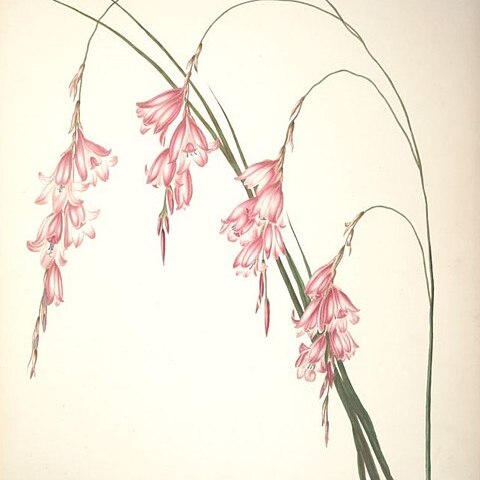Erect herb, 1-1.2 m tall. Corm 3-4 cm diam. Leaves numerous, rather lax and grass-like, 40-90 cm long, 4-8 mm wide, many-veined, glabrous. Scape terete, to 1.5 m long, glabrous; branches numerous, filiform, pendulous, subtended by subulate bracts 2-3 cm long. Spikes 2-5-flowered, axes filiform. Bracts acuminate, 2-2.5 cm long, whitish, finely striate, becoming torn. Flowers pink. Perianth tube c. 1 cm long; lobes obovate to elliptic, 1.8-2.5 cm long. Filaments 5-7 mm long; anthers 8-10 mm long, purple. Capsule globose, 3-lobed, c. 7 mm diam., papery.
Large evergreen clumps. Corm large, globose, tunic fibres splitting into long bristles at top. Stems 1-2 m high, arching, slender, terete. Leaves 45-90 × c. 1 cm, ± stiff, dull olive-green. Panicle with drooping filiform branches to 15 cm long; spathe-valves papery, ± 2 cm long, whitish, speckled with small brown lines. Flowers pinkish-purple, 3-3.5 cm long, 3-4 cm diam., 5-7 alternate, ± 1 cm apart towards extremities of branches. Capsule enclosed in persistent spathe-valves, ± 3.5 mm long Seeds few.
Perennial herb, geophyte, 1-2 m high, robust; corm 25-40 mm in diam. Leaves linear, apiculate; venation pronounced; reduced sheathing leaves 5. Flowering stems 1-2 m high. Inflorescence a raceme of spikes, with 3-7 lax branches. Bracts brown, 18-30 x 8-13 mm, narrowly obovate-oblanceolate to elliptic, ± acuminate, flecked. Perianth purplish pink, campanulate, rounded at base, 28-48 mm long; tube 8-13 mm long; tepals 20-32 x 8-12 mm. Flowering time Mar.-Dec.
Cormous perennial, 70-110 cm, stem slender and wiry, laxly branched. Leaves linear, fibrotic. Flowers nodding, in drooping spikes, pink.

